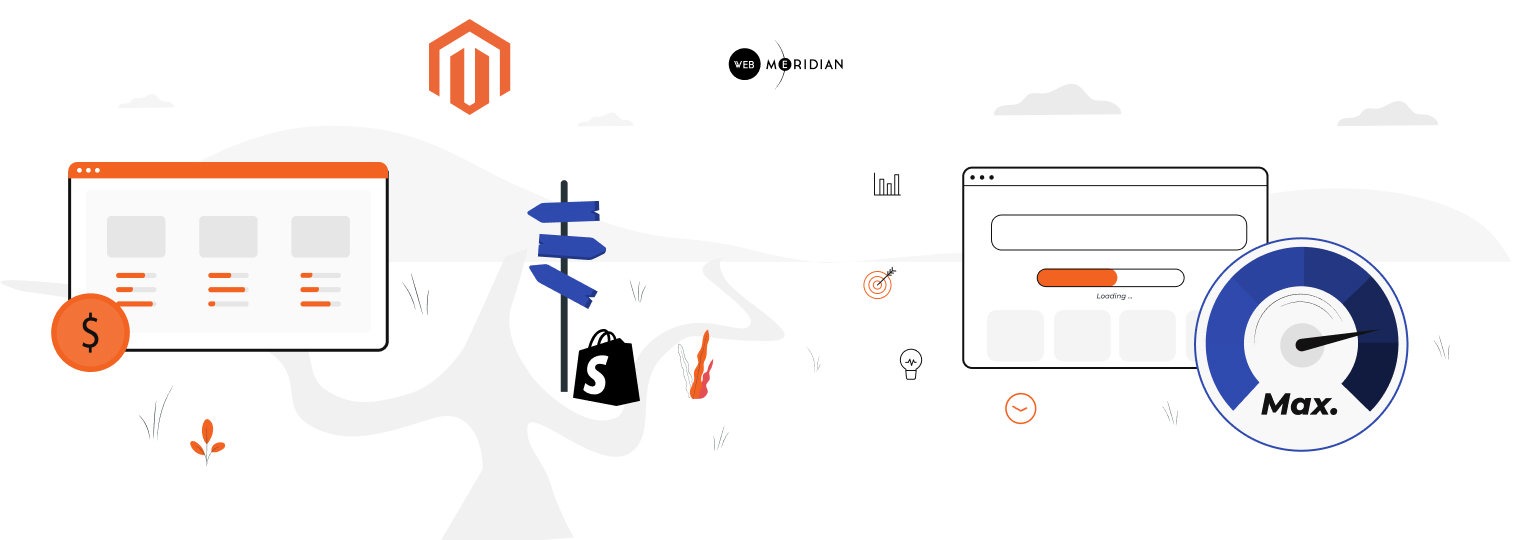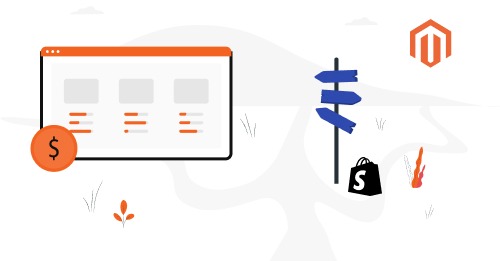How much does Magento eCommerce cost?
You might call it “blood, sweat, and clenched teeth.” On the other hand, this blog post will be more practical, with a focus on statistics and our own experience with Magento eCommerce costs.
Creating a Magento website needs unique qualifications. Developers who can complete this work charge varying fees. This cost is determined by the type of site you expect. An online store with a simple checkout process will be less costly to build. A website requiring a greater feature set will cost more since it will require more development.
- Magento eCommerce Cost: Comparison of 3 Options
- Magento Development Hourly Rates
- What is the Cost of a License in 2025?
- What Are the Other Major Factors That Influence Pricing?
- Magento Pricing Breakdown (Cost of Magento eCommerce Website)
- Magento eCommerce Pricing: Which Extensions Should be Included in Costs?
- How Can You Reduce the Cost of eCommerce Site Maintenance and Support?
- Checklist of Hidden Magento eCommerce Costs
- To Sum Up
Get A Magento Expert Consultation
Our Adobe Business Practitioner conducts site audit to optimize your eCommerce weaknesses.

Magento eCommerce Cost: Comparison of 3 Options
Website Development From Scratch
The total cost of the Magento eCommerce website includes developers’ hourly rates (30$-60$) as well as the scope of work required.
Every Magento eShop needs to have a crucial feature set in order to function correctly. Let’s take a look at the tasks that your online business will require:
| Step | Timeline | Description | Price |
|---|---|---|---|
| Step #1. Requirements Investigation Stage | It usually takes nearly 20-40 hours | It is a crucial milestone that aids in clarifying your specific requirements and the functioning of your online business. | $1800 |
| Step #2. Design of the Project's Architecture | Nearly 40-80 hours | At this step, the team of Adobe Certified Experts considers the overall project core and architecture. | $3600 |
| Step #3. Installation of Magento 2 | Nearly 1-2 hours | Following that, you will receive Magento 2 out-of-the-box capabilities that will require customisation. | $90 |
| Step #4. Implementations of the Backend | Needs at least 200 hours and depends on customisations you may need | Module installation, custom module creation, API development, and third-party integrations are common. | $9000 |
| Step #5. Implementations of the Frontend | Starts from 200 hours | It covers the installation of a theme as well as the creation of a custom theme. A project of this nature should take between 1000 and 2000 hours to complete. | $9000 |
| $20000-$35000 | |||
Magento 1 to Magento 2 Migration Cost
Migrating from Magento 1 to Magento 2 takes about 50 to 790 hours, or an average of 4-6 months.
| Stages of Magento 2 Migration | Timeline | Magento 1 to 2 Migration Cost |
|---|---|---|
| Preliminary analysis and planning | typically takes about 20 to 40 hours | $800-$1600 |
| Installation of Magento 2 and its configuration | takes 10-40 hours. Depends on the complexity of the server configuration and client requirements. | $400-$1600 |
| Data migration | takes 40-120 hours. This stage includes migrating products, categories, orders, customers, etc. The time for this stage may vary significantly based on the volume and complexity of the data. | $1600-$4800 |
| Migrating compatible third-party extensions | only takes a few days, about 10 to 60 hours. | $400-$2400 |
| Non-compatible extensions | usually takes longer but work in the same range, 10–60 hours. | $400-$2400 |
| Setting up and customization of the new theme | ranges from 50 to 250 hours. It includes creating a new theme for Magento 2 or adapting an existing one and customizing functionality. | $2250-$10000 |
| The customization of codes | typically takes about 20 to 200 hours. | $800-$8000 |
| Testing and bug fixing | takes about 20-100 hours. Thoroughly test all aspects of the site to identify and correct errors. | $800-$4000 |
| Unforeseen work | It is always worth leaving a reserve of time for unforeseen situations, typically 10%-20%. | |
| Total | 180-700 Hours | $5000-$35000 |
Revamp Your Store with the Latest Magento Version!
Upgrade to the latest version, resolve compatibility issues, and leverage top-notch applications and integrations.

What customisation encompasses as an action. Customization is required if you need to rebuild or replace particular default features for your company’s needs. This necessitates more developer effort and may be accounted for as extra development hours.
You may change the theme, modules, and shop features like goods, orders, search, login, and checkout. You may also contact us to adapt any feature for your shop and enable you to understand the prices based on our estimates. A tailored solution ensures that you do not squander money on features and capabilities that you do not require.
Magento developer costs in Ukraine per hour can range from $35 to $55. The actual rate will depend on several factors.
One such aspect is your Magento store’s development requirements. A simple shop with less technical development would be less costly, and vice versa.
Another consideration is the developers’ location. For the same work, various developers may charge different fees. Their rates are determined by the country of origin of the developers. Some locations, such as the United States and European countries, may have larger rates than Ukraine or Poland. It is determined by the global market and the country’s tax system.
In addition to the pricing, we suggest you consider a web developer’s expertise and capabilities. Some abilities can only be learned through experience. You may verify it by asking for the developer’s CV and portfolio, conducting a face-to-face interview, or participating in several free trial hours.
Magento Development Hourly Rates
What is the Cost of a License in 2025?
There are three Magento editions with different pricing plans: Magento Open Source, Magento Commerce, and Magento Commerce Cloud. In 2018, Magento was acquired by Adobe, with the consequential renaming of the software editions into Adobe Commerce and Adobe Commerce Cloud respectively.
The overall Magento eСommerce pricing looks the following way:
| Magento Edition | Price |
|---|---|
| Magento Open Source | $0 |
| Magento Commerce | $22,000/year – $125,000/year |
| Magento Commerce Cloud | $40,000/year – $190,000/year |
Let’s briefly inspect each version’s characteristics:
- Magento Open Source is a free edition. You can download and install it without any payments, with further customization according to your business goals. This is a great opportunity for small and medium-sized organizations to start their Magento journey.
- Magento Commerce is a paid version that contains lucrative features like B2B functionality, a business intelligence dashboard, comprehensive marketing and analytics tools, customer loyalty features, and more. It provides extensive flexibility and customization options, making it an excellent choice for medium and large e-commerce companies. Magento Commerce pricing plans are tied to the annual revenue levels.
- Magento Commerce Cloud is similar to the Magento Commerce Edition in the sense that it matches the needs of larger businesses. Its fundamental difference from Magento Commerce lies in the opportunity to store all your data in the Cloud. Furthermore, this version ensures quick page loading with Content Delivery Network, offers performance control tools, and more. The exclusive inherent features make Magento Commerce Cloud more expensive.
Depending on the annual sales volumes of your company, you can expect the following pricing plans for Magento Commerce and Magento Commerce Cloud:
| Annual Gross Revenue | Annual Magento Commerce Pricing | Annual Magento Commerce Cloud Pricing |
|---|---|---|
| Below $1,000,000 | $22,000 | $40,000 |
| $1,000,000 - $5,000,000 | $32,000 | $55,000 |
| $5,000,000 - $10,000,000 | $49,000 | $80,000 |
| $10,000,000 - $25,000,000 | $75,000 | $120,000 |
| Above $25,000,000 | $125,000 | $190,000 |
Get A Magento Expert Consultation
Our Adobe Business Practitioner conducts site audit to optimize your eCommerce weaknesses.

Since Magento provides a wide variety of native features, you may require adjustments or be better suited for Magento’s corporate edition. The following are some significant aspects that will influence the eСommerce site development cost and your choice:
- Size of your business: This will have a direct impact on your experience and budget for Magento development costs. If you own a small or medium-sized business, you may want to explore Basic or Custom. If you are a large corporation, you may select the enterprise kind.
- Approach: You must determine whether to develop a new one or re-platform.
- Third-party integrations: If you intend to integrate, you must estimate the number of third-party platforms which will be integrated into your Magento 2 site. Dropship, Magento ERP, accounting, shipping, and PIM systems are examples of third-party systems.
- SKUs: This directly impacts the custom eCommerce website development cost. As a result, you must determine how many SKUs you will need to accommodate.
- Design: eCommerce platforms such as Magento, Shopware, Shopify, and WooCommerce have a bespoke theme (template set) as well as a paid theme. You’ll have to determine which one your site requires. You must also decide whether to employ sophisticated mobile templating, such as adaptive templates, custom data sets, and AMP sites.
- Migration: One element to consider when assessing eСommerce site development cost is your website’s capacity to manage sophisticated data migration. Data normalisation, customer integration, price data, product data (custom/configurable/group products, dimension data, rich data), and data manipulations are all part of this feature (cleaning, merging, updating).
- Fulfilment: Order fulfilment is a must for all online businesses. As a result, this aspect significantly impacts eCommerce site development costs. You must consider whether your website requires the management of sophisticated shipping rules, such as warehouse shipping setups. You must also explore payment alternatives, which will directly impact your income. Gift cards, sophisticated tax pricing extension, tax settings, and various currency support are examples of payment choices.
- Marketing: You must define your marketing integration requirements, such as email integration, autoresponders, and social media integration, among others.
What Are the Other Major Factors That Influence Pricing?
Magento Pricing Breakdown (Cost of Magento eCommerce Website)
| Expense Item | Magento Open Source | Magento Commerce | Magento Commerce Cloud |
|---|---|---|---|
| Magento edition cost | - | $22000-$125000/ year | $40000-$90000/ year |
| Hosting | $100-$500/ year | $500-$6500/year | - |
| Domain name | $10-$400/ year | $10-$400/ year | $10-$400/ year |
| SSL certificate | $50-$300/ year | $50-$300/ year | $50-$300/ year |
| Store Design | $0-$5000+ | $0-$5000+ | $0-$5000+ |
| Magento Development | $1800-$10000+ | $10000+ | $10000+ |
| Extensions | $60-$600+ per one | $100-$600+ per one | $100-$600+ per one |
| Payment providers fees | 2.9%+$0.30 per transaction | 2.9%+$0.30 per transaction | 2.9%+$0.30 per transaction |
| SEO & Promotion | $5000-$20000+/ year | $5000-$20000+/ year | $5000-$20000+/ year |
Magento eCommerce Pricing: Which Extensions Should be Included in Costs?
To begin with, let’s point out several fundamental extension groups that are recommended for eCommerce stores. Each group contains both free and paid solutions. The paid ones can cost from $99 to roughly $200-$400 per month.
Consider the following primary categories:
- Payment gateways. By integrating with reliable payment gateways like PayPal, Stripe, Braintree, or Authorize.Net., you’ll grant your customers the choice of the payment method they prefer.
- Shipping solutions. Your clients should likewise have freedom of choice in terms of delivery options. Shipping extensions provide real-time delivery rates, label printing, and order tracking integration with major carriers.
- Security. Implementing solid security measures such as SSL certificates, firewalls, and malware detection protects sensitive customer data, builds trust, and safeguards the store’s reputation.
- SEO optimization. These extensions optimize product pages, meta tags, and URLs to elevate search engine visibility and spur organic traffic to the store.
- Analytics and reporting. You need to assess your store’s operation to set further goals. Analytic tools provide insights into website performance, customer behavior, and sales trends, enabling informed decision-making and strategic planning.
Based on our experience, we can recommend several practical Magento eCommerce extensions worth noting. Their pricing can vary; the table below introduces average estimates.
| Extension Type | Core Functionality | Approximate price |
|---|---|---|
| Layered Navigation Extension | Enhances store’s usability and navigation, including performance, product filters, and visual customization. | $199 |
| GeoIP Redirect | Allows you to track customers' location and redirect them to a relevant website in the local language and regional currency, based on the user’s IP address. | $179 |
| Abandoned Cart Email Extension | Contains all the necessary tools to establish and run abandoned cart email campaigns | $219 |
| Lazy Load | Optimizes media files, improving your website’s loading speeds. | $189 |
| Order Editor | Allows customers to alter their orders as well as payment/shipping/billing data. | $149 |
| One step checkout | Arranges all checkout steps on one page and enables checkout template customization. | $319 |
Begin eCommerce Website Optimization
The structure of a website is akin to the foundation of a house. Lay a solid groundwork for your business's growth with a properly configured store.

Every eCommerce business owner wants to save expenses wherever possible, and Magento support price is no exception. At the same time, cost-cutting measures should be pretty sensible because there is a set of necessary support services that you must constantly conduct in order to maintain your website operating at peak capacity.
How Can You Reduce the Cost of eCommerce Site Maintenance and Support?
It’s crucial to remember that even if you have a support package and, of course, guaranteed hours, you may still receive a Magento support cost that’s greater than planned. We aim for transparency at WebMeridian so that you always know what to anticipate.
With years of expertise in Magento website maintenance, we’ve heard numerous stories from our clients about unexpected charges while working with various development firms and intermediates. Based on this, we’ve compiled a list of questions to ask the company’s sales manager or e-commerce consultant before entering into a Magento 2 maintenance agreement for your website.
- How do you create the project support estimate? What factors may have an impact on costs during our collaboration?
- How do you keep my store’s data safe and secure?
- Whom should I contact if there are any problems with the website?
- Who will maintain and/or support my Magento website? What is their experience like?
- How knowledgeable is your development team?
- Can you (the development agency) give me any warranties? How long can they be expected to last?
- What happens when the warranty expires?
- Does the price cover the cost of enhancements and updates?
- How much do critical Magento 2 updates cost?
- Do you provide a service-level agreement (SLA)?
Checklist of Hidden Magento eCommerce Costs
We are delighted to provide you with this guidance regarding the project’s cost on Magento 2. Please contact us if you want assistance in estimating your project. We will be delighted to create an outstanding online store on Magento 2 for you at no extra cost!
To Sum Up
No More Lost Customers!
We offer tech audit and implementing of new theme with a hot feature set to rekindle customer interest and drive additional sales.

The total cost of the Magento eCommerce website includes developers’ hourly rates (30$-60$) as well as the scope of work required. A project of this nature should take between 500 and 2000 hours to complete.
As a result, the licensing fee for a premium Magento installation ranges from $22,000 to $190,000 per year for merchants with annual sales exceeding $25,000,000. (if the cloud version is chosen).
The primary distinction is that Shopify is a hosted platform, whereas Magento is self-hosted. Shopify, for example, is a hosted platform that takes care of all your hosting concerns. All hosting fees are included in your monthly plan, so you don't have to do anything additional.





